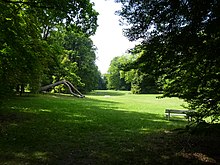Dörnbergpark
| Dörnbergpark | |
|---|---|
| Park in Regensburg | |

|
|
| Dörnbergpalais, view from the east | |
| Basic data | |
| place | regensburg |
| Created | 1804 |
| Newly designed | 1867 |
| Buildings | Dörnberg Palace |
| use | |
| Park design | English landscape park |
| Technical specifications | |
| Parking area | 7.4 ha |
Coordinates: 49 ° 0 '57.9 " N , 12 ° 5' 8.4" E
The Dörnbergpark is a 7.4 hectare park, a little to the west of St. Emmeram Castle and the Helenentor , the exit from the old town of Regensburg . From Bismarckplatz this significant monument of landscape art of the 19th century is also just south away.
history
The Jewish banker and court factor of the Princes of Thurn and Taxis , Philipp Reichenberger, had a suburban villa, today's Dörnbergpalais , and a 1.9 m. From 1804 to 1806 according to plans by Emanuel Herigoyen 500 m south of the then still preserved city wall on Bismarckplatz Build a hectare park. In 1832, Baron Ernst Friedrich von Dörnberg (1801–1878), general administrator of the Princes of Thurn and Taxis from 1828 to 1871, acquired the property. He was the brother of Wilhelmine von Dörnberg , who had been married to Maximilian Karl von Thurn und Taxis since 1828 . After four births, she became sickly in 1832, became seriously ill in 1834 and died. Her brother had bought the Dörnbergpalais with the park in the hope of being able to give his sister a place of relaxation with a suitable renovation of the palace and an extension of the park.
Ernst Friedrich von Dornberg extended the park considerably to its current size south to the August Street and west to the Hoppe road and left the park in the years 1864-1867 by the Royal Bavarian court gardener Carl von Effner with the planting of 1,400 trees of various species to English Designing a landscape park . Today there are only about 250 trees in the park, half of them beeches. The park buildings that still exist (Swiss House / Rosarium (1871), community house, gardener's house and greenhouse) and the abandoned buildings (machine house with water tower and steam engine for irrigation, horse stable and carriage shed, bark house, pavilion) also date from the time of the park. . In 1947 the palace, buildings and park were placed under monument protection.
Since the death of his heirless son Ernst von Dörnberg (1836-1897) in 1897, the Dörnbergpalais and the park have been managed by the Gräflich von Dörnberg'schen Orphan Fund Foundation. As stipulated in the will, the park was initially closed, only from 1921 to 1926 and since 1938 it was opened to the public. A custody contract from 1956 between the foundation and the city of Regensburg regulates the opening and maintenance of the park.
Park description
The 7.4 hectare park has an east-west extension of 375 m and a north-south extension of 270 m. It is located on average at an altitude of 340 m above sea level. Of the approx. 1400 trees, around 30% are older than 100 years and thus come from the original stock of the 19th century. Characteristic for the 63 species (37 deciduous trees, conifers 26) of the park are beech (tufts Book), Maple -Haine and outlandish specimen trees ( copper beech , black walnut , chestnut ). About 26 species of birds and the bat Noctule are native to the park.
Preservation, temporary closure and reopening of the park
At the beginning of 2018, the park had to be closed for security reasons. Research in 2008 had already shown that the roots of the beech trees , which had reached the end of their natural age after a good 250 years, were infested with the phytophthora fungus, which destroys plants . A rescue attempt that had lasted several years was unsuccessful, because the burn crust fungus was added as a parasitic secondary pest , which causes mold rot in the roots and regions of the trunk close to the ground. The fungal attack can reduce the stability of the trees so much that even externally symptom-free trees can topple without warning. This is why the popular park was closed for one year in 2018. The reopening was realized in February 2019 after four trees had been felled and more trees had been secured with more than 200 individual measures including torso solutions. The investigations also showed that the park has the highest biotope value because of its old trees with many caves.
literature
- Georg Dehio : Handbook of the German art monuments. Volume 5, 1949. Page 619.
- The Counts of Dörnberg and their foundation. Regensburg: Mittelbayerische Dr.- und Verl.-Anst., 1991.
Individual evidence
- ^ Karl Bauer: Regensburg Art, Culture and Everyday History . 6th edition. MZ-Buchverlag in H. Gietl Verlag & Publication Service GmbH, Regenstauf 2014, ISBN 978-3-86646-300-4 , p. 595-597 .
- ↑ [1] , Mittelbayerische Zeitung of February 16, 2019, accessed on February 17, 2019.
Remarks
- ↑ The information in this section is completely out of date

